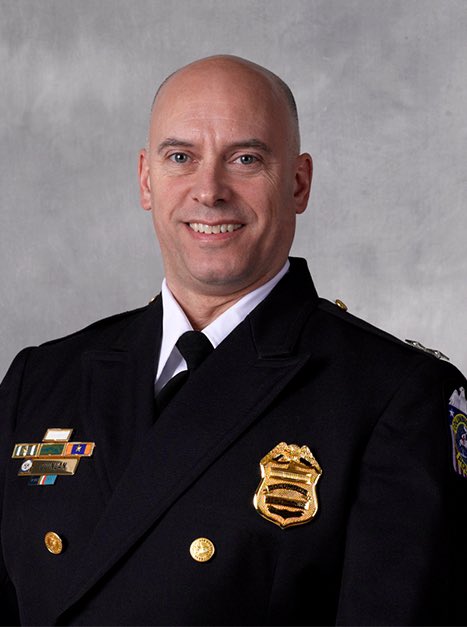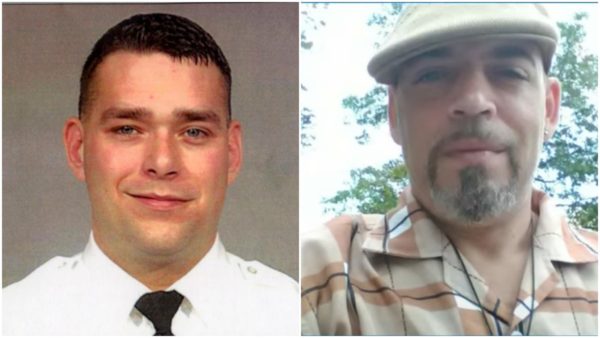‘Columbus Residents Have Lost Faith In Him’: Police Chief Demoted In Ohio City a Month After It Saw Two Black Men Killed By Law Enforcement Officers
The blood of Casey Goodson and Andre Hill still stain the city of Columbus, Ohio. Both Black men were killed by law enforcement personnel in two separate high-profile encounters that occurred within weeks of each other in December.
And on Thursday, Columbus Mayor Andrew Ginther moved to replace Police Chief Thomas Quinlan, saying he’d lost trust in the top cop’s ability to reform the police agency. Ginther announced that Quinlan, 54, stepped down at his request and said a nationwide search will soon be underway to find his successor. Deputy Chief Mike Woods will serve in an interim role while the city looks for its next permanent police chief.

“It became clear to me that Chief Quinlan could not successfully implement the reform and change I expect and that the community demands,” Ginther said in a prepared video statement. “Columbus residents have lost faith in him and in the Division’s ability to change on its own. Chief Quinlan understood.”
It was a public vote of no confidence little more than a year after Ginther appointed Quinlan to the helm of the Columbus Division of Police in December 2019. And it came about five weeks after Adam Coy, a 19-year veteran officer fatally shot Andre Hill.
Hill, a 47-year-old Black man, was unarmed when Coy killed him early the morning of Dec. 22 during a non-emergency call. Coy opened fire within 10 seconds of encountering Hill after the man emerged from an open garage holding a cellphone in his hand.
Amy Detwiler, Coy’s partner on the call, said she never saw a gun or perceived a threat. Civil rights attorney Benjamin Crump, who is representing Hill’s family, said the man dropped by the house to visit a friend, according to CNN.
Bodycam footage showed officers on scene failed to administer medical aid for at least five minutes and handcuffed Hill as he lay on the garage floor dying.
Quinlan called Coy’s actions “reckless and deliberate” and recommended his termination. The officer was fired Dec. 28. A criminal investigation into the shooting was opened.

Hill’s death came on the heels of another Black man’s death that sparked national outrage.
Casey Goodson, 23, was shot dead Dec. 4 as he entered his home in an unincorporated section of north Columbus. Franklin County sheriff’s deputy Jason Meade, a SWAT deputy, was working as a U.S. Marshals Fugitive Task Force agent when he followed Goodson in a car to his home and then shot him in his yard. Goodson was not a target of the manhunt. According to Meade’s attorney, the deputy claims Goodson pointed a gun at him.
While that shooting didn’t happen in the Columbus Division of Police jurisdiction, the agency was assigned to oversee the investigation into Goodson’s death.
Quinlan was officially hired in February. His one-year probationary period was set to end next month. Quinlan has now been bumped back to deputy chief.
The former chief oversaw a police force of 1,800 sworn officers and 300 civilian employees that serves a metropolitan area with nearly 800,000 residents. Quinlan has been with the agency for 30 years.
In a prepared statement of his own Thursday, Quinlan indicated it was Public Safety Director Ned Pettus Jr. who made the decision to replace him. He made no mention of Hill or Goodson’s shootings, but he touted reforms he said he helped implement.
“I respect the Safety Director’s decision, and the community’s need to go in a different direction,” Quinlan said. “We accomplished a lot in my time as Chief. We implemented dozens of reforms geared toward accountability, transparency, and strengthening public trust. Someone else will now carry those priorities forward, and I will help and support them in any way I can.”
Ginther said national search firm Ralph Andersen & Associates will help the city find a new police chief “on an expedited timeframe.” He said he plans make appointments to a Civilian Police Review Board in the coming weeks. The nine-member panel will select an inspector general to give Columbus “civilian oversight of police for the first time in our city’s history,” Ginther proclaimed.
Columbus voters in November passed a charter amendment that paved the way for the review board and inspector general. The measure was approved by a nearly 3-to-1 margin.
Columbus has also earmarked $4.5 million to equip officers with “next-generation” body cameras that will replace the cameras police currently wear.
“I remain committed to meaningful, lasting police reform and confronting racism where it exists, advancing social justice so everyone in every neighborhood feels safe,” the mayor said.
Not all were sold on Ginther’s reform plan. One Twitter user said the city’s next top cop needs to neutralize the local police union in order to be effective.
“Whoever the new police chief is they need to have the authority to fire cops without @capcityfop interference,” Zachary Schroeder responded to Ginther’s statement on Twitter. “If that’s not fixed nobody good will want to take a job where they will have their hands tied from the start.”
In 2020, Columbus had a record number of homicides with 174, ABC 6 reported. The Associated Press reviewed the city’s use-of-force records between 2015 and 2019, and they revealed Black residents accounted for about half of those encounters with police. Columbus’ Black population is just 28 percent.
Chanelle Jones, a dean of community engagement at Franklin University, told AP the next police chief should be hired from outside the city.
“We need someone who can come with a fresh lens that didn’t grow up in the culture of Columbus Division of Police or the culture of policing within the state of Ohio,” said Jones, a member of a police reform commission that Ginther convened two years ago.

